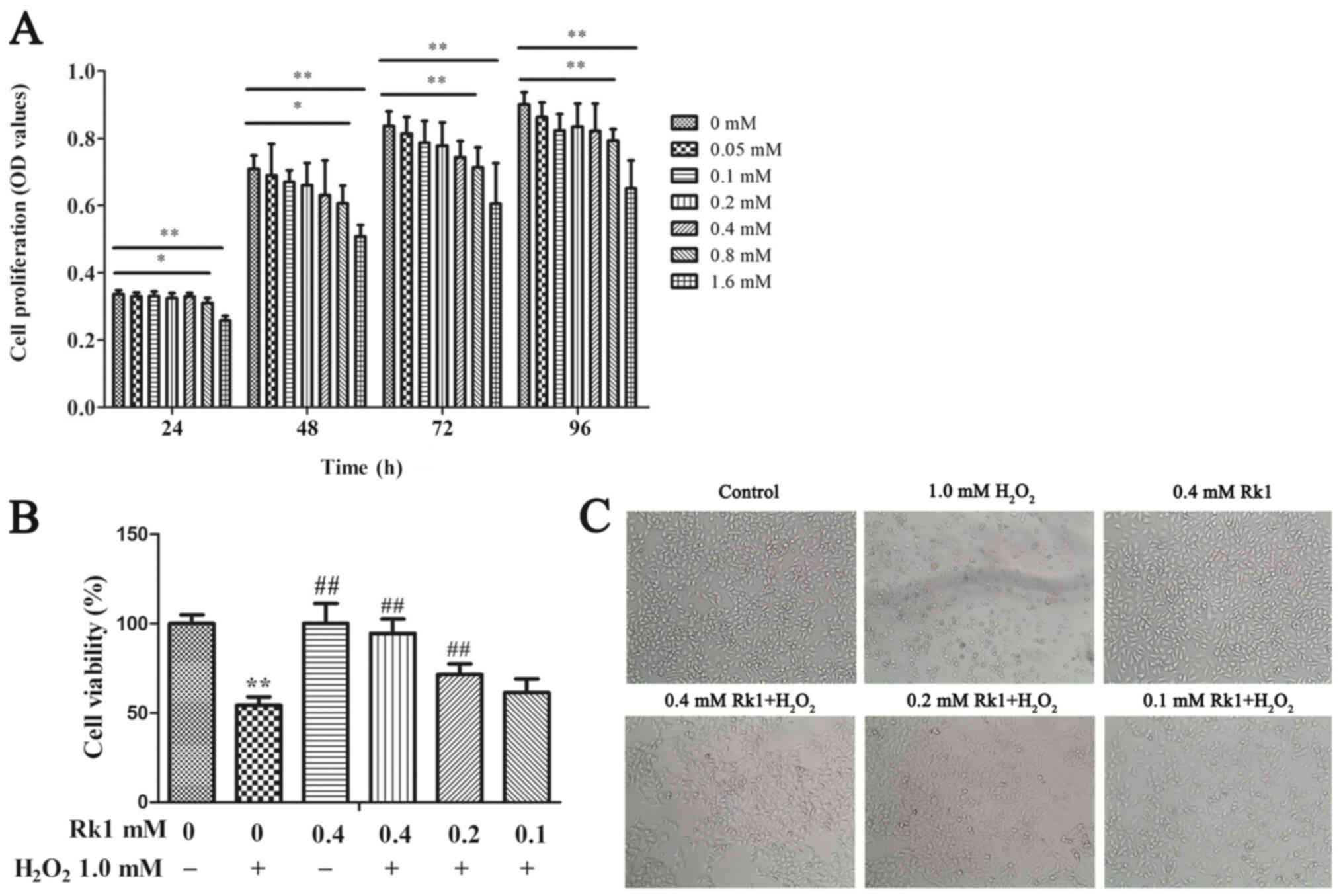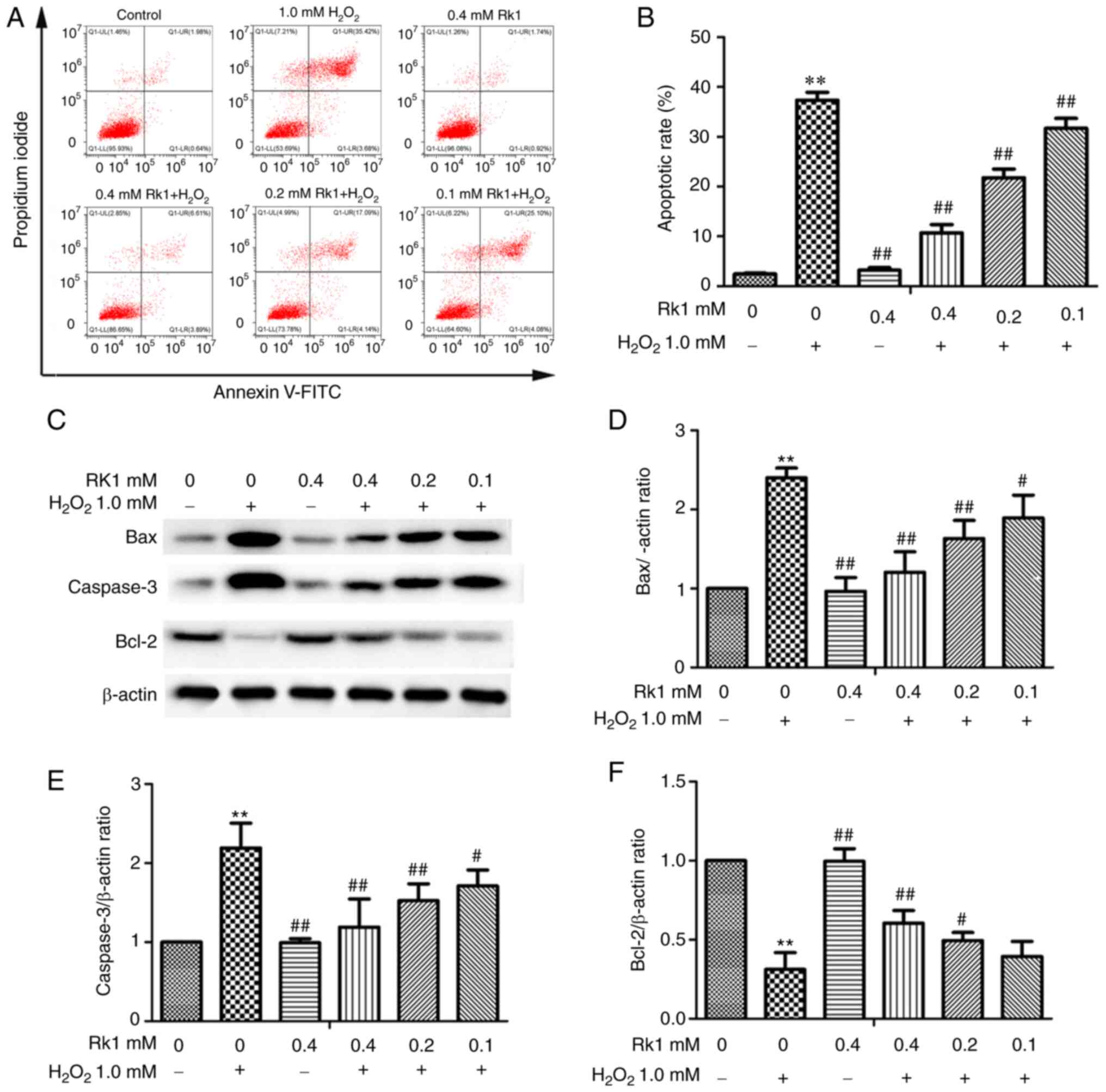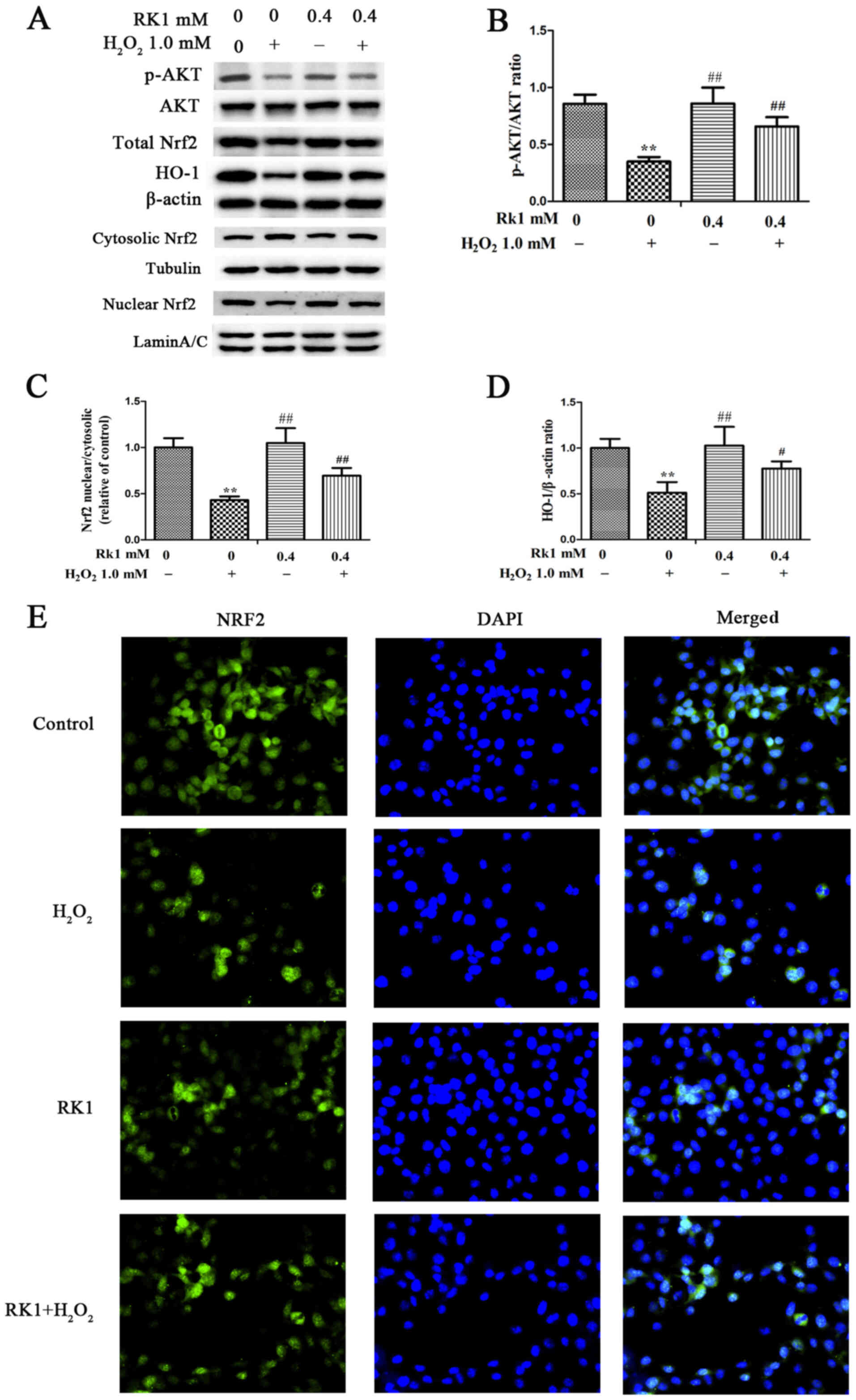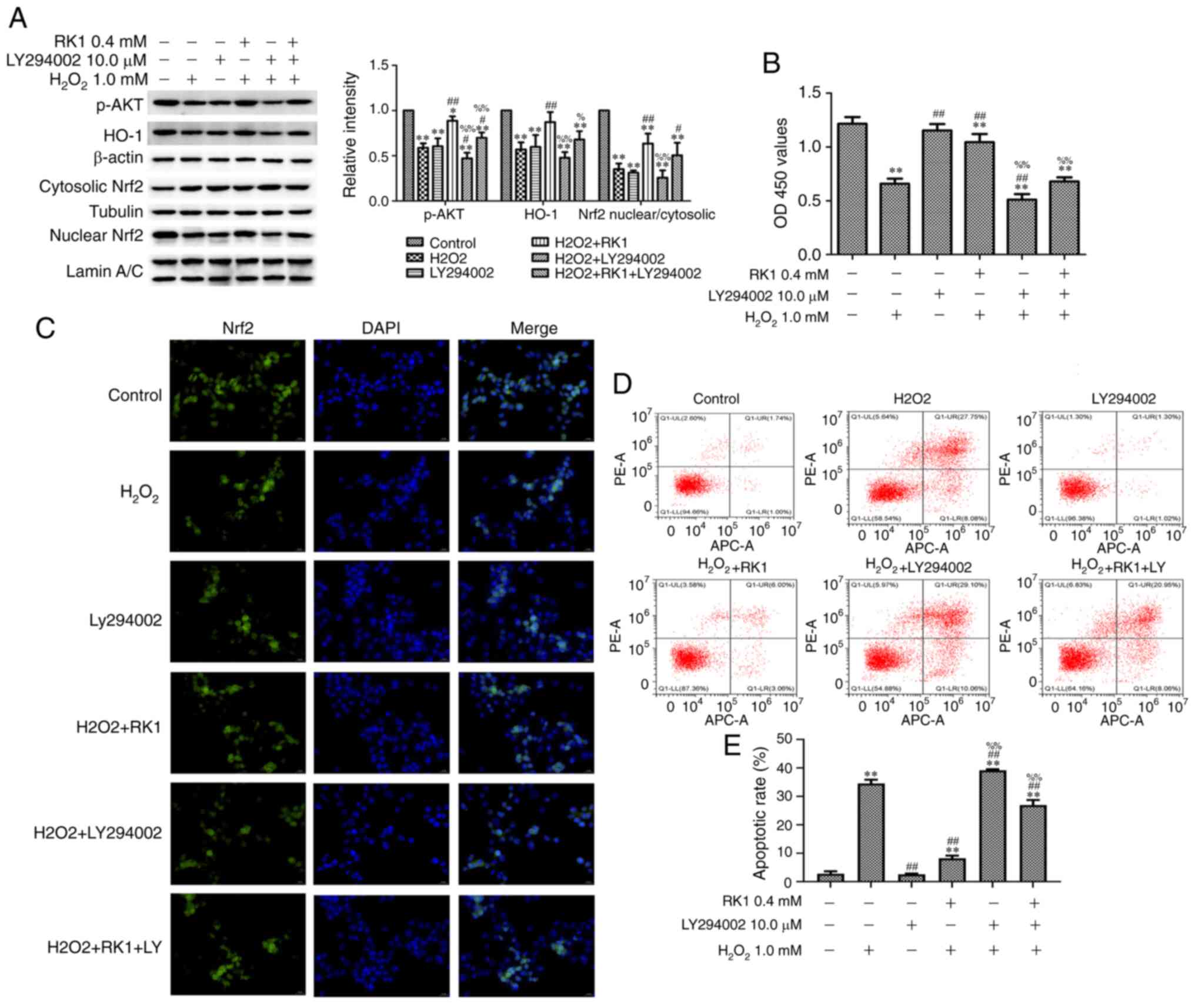|
1
|
Dey-Rao R and Sinha AA: Interactome
analysis of gene expression profile reveals potential novel key
transcriptional regulators of skin pathology in vitiligo. Genes
Immunity. 17:30–45. 2016. View Article : Google Scholar : PubMed/NCBI
|
|
2
|
Saleh MA, Mahran OM and Bassam Al-Salahy
M: Circulating oxidative stress status in dromedary camels infested
with sarcoptic mange. Vet Res Commun. 35:35–45. 2011. View Article : Google Scholar : PubMed/NCBI
|
|
3
|
Fatehi-Hassanabad Z, Chan CB and Furman
BL: Reactive oxygen species and endothelial function in diabetes.
Eur J Pharmacol. 636:8–17. 2010. View Article : Google Scholar : PubMed/NCBI
|
|
4
|
Shi Q, Zhang W, Guo S, Jian Z, Li S, Li K,
Ge R, Dai W, Wang G, Gao T and Li C: Oxidative stress-induced
overexpression of miR-25: The mechanism underlying the degeneration
of melanocytes in vitiligo. Cell Death Differ. 23:496–508. 2016.
View Article : Google Scholar : PubMed/NCBI
|
|
5
|
Guo S and Zhang Q: Paeonol protects
melanocytes against hydrogen peroxide-induced oxidative stress
through activation of Nrf2 signaling pathway. Drug Dev Res. Jan
24–2021.(Epub ahead of print). View Article : Google Scholar : PubMed/NCBI
|
|
6
|
Zhuang T, Li S, Yi X, Guo S, Wang Y, Chen
J, Liu L, Jian Z, Gao T, Kang P and Li C: Tranilast directly
targets NLRP3 to protect melanocytes from keratinocyte-derived
IL-1β under oxidative stress. Front Cell Dev Biol. 8:5882020.
View Article : Google Scholar : PubMed/NCBI
|
|
7
|
Yang L, Yang F, Teng L and Katayama I:
6-shogaol protects human melanocytes against oxidative stress
through activation of the Nrf2-antioxidant response element
signaling pathway. Int J Mol Sci. 21:35372020. View Article : Google Scholar : PubMed/NCBI
|
|
8
|
Ma J, Li S, Zhu L, Guo S, Yi X, Cui T, He
Y, Chang Y, Liu B, Li C and Jian Z: Baicalein protects human
vitiligo melanocytes from oxidative stress through activation of
NF-E2-related factor2 (Nrf2) signaling pathway. Free Radic Biolo
Med. 129:492–503. 2018. View Article : Google Scholar : PubMed/NCBI
|
|
9
|
Li XS, Tang XY, Su W and Li X: Vitexin
protects melanocytes from oxidative stress via activating
MAPK-Nrf2/ARE pathway. Immunopharmacol Immunotoxicol. 42:594–603.
2020. View Article : Google Scholar : PubMed/NCBI
|
|
10
|
Qiao Z, Xu Z, Xiao Q, Yang Y, Ying J,
Xiang L and Zhang C: Dysfunction of ATG7-dependent autophagy
dysregulates the antioxidant response and contributes to oxidative
stress-induced biological impairments in human epidermal
melanocytes. Cell Death Discov. 6:312020. View Article : Google Scholar : PubMed/NCBI
|
|
11
|
Hu Y, Huang J, Li Y, Jiang L, Ouyang Y, Li
Y, Yang L, Zhao X, Huang L, Xiang H, et al: Cistanche deserticola
polysaccharide induces melanogenesis in melanocytes and reduces
oxidative stress via activating NRF2/HO-1 pathway. J Cell Mol Med.
24:4023–4035. 2020. View Article : Google Scholar : PubMed/NCBI
|
|
12
|
Choi SJ and Kim HS: Deregulation of
Nrf2/ARE signaling pathway causes susceptibility of
dystrophin-deficient myotubes to menadione-induced oxidative
stress. Exp Cell Res. 364:224–233. 2018. View Article : Google Scholar : PubMed/NCBI
|
|
13
|
Ramprasath T, Vasudevan V, Sasikumar S,
Puhari SS, Saso L and Selvam GS: Regression of oxidative stress by
targeting eNOS and Nrf2/ARE signaling: A guided drug target for
cardiovascular diseases. Curr Top Med Chem. 15:857–871. 2015.
View Article : Google Scholar : PubMed/NCBI
|
|
14
|
Ndisang J: Synergistic interaction between
heme oxygenase (HO) and nuclear-factor E2-related factor-2 (Nrf2)
against oxidative stress in cardiovascular related diseases. Curr
Pharm Design. 23:1465–1470. 2017. View Article : Google Scholar : PubMed/NCBI
|
|
15
|
Lin CC, Hsiao LD, Cho RL and Yang CM:
CO-releasing molecule-2 induces Nrf2/ARE-dependent heme oxygenase-1
expression suppressing TNF-α-induced pulmonary inflammation. J Clin
Med. 8:4362019. View Article : Google Scholar : PubMed/NCBI
|
|
16
|
Chen S, Li X, Wang Y, Mu P, Chen C, Huang
P and Liu D: Ginsenoside Rb1 attenuates intestinal
ischemia/reperfusioninduced inflammation and oxidative stress via
activation of the PI3K/Akt/Nrf2 signaling pathway. Mol Med Rep.
19:3633–3641. 2019.PubMed/NCBI
|
|
17
|
Shen R, Laval S, Cao X and Yu B: Synthesis
of Δ 20-ginsenosides Rh4,
(20E)-Rh3, Rg6, and Rk1: A general
approach to access dehydrated ginsenosides. J Org Chem.
83:2601–2610. 2018. View Article : Google Scholar : PubMed/NCBI
|
|
18
|
Kim JE, Lee W, Yang S, Cho SH, Baek MC,
Song GY and Bae JS: Suppressive effects of rare ginsenosides, Rk1
and Rg5, on HMGB1-mediated septic responses. Food Chem Toxicol.
124:45–53. 2019. View Article : Google Scholar : PubMed/NCBI
|
|
19
|
Wang W, Wang S, Liu J, Cai E, Zhu H, He Z,
Gao Y, Li P and Zhao Y: Sesquiterpenoids from the root of Panax
Ginseng protect CCl4-induced acute liver injury by
anti-inflammatory and anti-oxidative capabilities in mice. Biomed
Pharmacother. 102:412–419. 2018. View Article : Google Scholar : PubMed/NCBI
|
|
20
|
Qi ZL, Wang Z, Li W, Hou JG, Liu Y, Li XD,
Li HP and Wang YP: Nephroprotective effects of anthocyanin from the
fruits of Panax ginseng (GFA) on cisplatin-induced acute kidney
injury in mice. Phytother Res. 31:1400–1409. 2017. View Article : Google Scholar : PubMed/NCBI
|
|
21
|
Yang CC, Chen CY, Wu CC, Koo M, Yu ZR and
Wang BJ: Panax ginseng fraction F3 extracted by supercritical
carbon dioxide protects against oxidative stress in ARPE-19 CElls.
Int J Mol Sci. 17:17172016. View Article : Google Scholar : PubMed/NCBI
|
|
22
|
Shen W, Wei Y, Tang D, Jia X and Chen B:
Metabolite profiles of ginsenosides Rk1 and Rg5 in zebrafish using
ultraperformance liquid chromatography/quadrupole-time-of-flight
MS. J Ginseng Res. 41:78–84. 2017. View Article : Google Scholar : PubMed/NCBI
|
|
23
|
Hu JN, Xu XY, Li W, Wang YM, Liu Y, Wang Z
and Wang YP: Ginsenoside Rk1 ameliorates paracetamol-induced
hepatotoxicity in mice through inhibition of inflammation,
oxidative stress, nitrative stress and apoptosis. J Ginseng Res.
43:10–19. 2019. View Article : Google Scholar : PubMed/NCBI
|
|
24
|
Chang Y, Li S, Guo W, Yang Y, Zhang W,
Zhang Q, He Y, Yi X, Cui T, An Y, et al: Simvastatin protects human
melanocytes from H2O2-induced oxidative
stress by activating Nrf2. J Invest Dermatol. 137:1286–1296. 2017.
View Article : Google Scholar : PubMed/NCBI
|
|
25
|
Jiang W, Li S, Chen X, Zhang W, Chang Y,
He Y, Zhang S, Su X, Gao T, Li C and Jian Z: Berberine protects
immortalized line of human melanocytes from HO-induced oxidative
stress via activation of Nrf2 and Mitf signaling pathway. J
Dermatol Sci. 94:236–243. 2019. View Article : Google Scholar : PubMed/NCBI
|
|
26
|
Yamamoto A, Yang L, Kuroda Y, Guo J, Teng
L, Tsuruta D and Katayama I: Local epidermal endocrine estrogen
protects human melanocytes against oxidative stress, a novel
insight into vitiligo pathology. Int J Mol Sci. 22:2692020.
View Article : Google Scholar : PubMed/NCBI
|
|
27
|
Shalbaf M, Gibbons NC, Wood JM, Maitland
DJ, Rokos H, Elwary SM, Marles LK and Schallreuter KU: Presence of
epidermal allantoin further supports oxidative stress in vitiligo.
Exp Dermatol. 17:761–770. 2008. View Article : Google Scholar : PubMed/NCBI
|
|
28
|
Becatti M: Oxidative stress and
high-mobility group box 1 (HMGB1) protein release in vitiligo. Br J
Dermatol. 176:1436–1437. 2017. View Article : Google Scholar : PubMed/NCBI
|
|
29
|
Cui T, Zhang W, Li S, Chen X, Chang Y, Yi
X, Kang P, Yang Y, Chen J, Liu L, et al: Oxidative stress-induced
HMGB1 release from melanocytes: A paracrine mechanism underlying
the cutaneous inflammation in vitiligo. J Invest Dermatol.
139:2174–2184.e4. 2019. View Article : Google Scholar : PubMed/NCBI
|
|
30
|
Ahn S, Siddiqi MH, Aceituno VC, Simu SY,
Zhang J, Jimenez Perez ZE, Kim YJ and Yang DC: Ginsenoside Rg5: Rk1
attenuates TNF-α/IFN-γ-induced production of thymus- and
activation-regulated chemokine (TARC/CCL17) and LPS-induced NO
production via downregulation of NF-κB/p38 MAPK/STAT1 signaling in
human keratinocytes and macrophages. In Vitro Cell Dev Biol Anim.
52:287–295. 2016. View Article : Google Scholar : PubMed/NCBI
|
|
31
|
Hong Y and Fan D: Ginsenoside Rk1 induces
cell cycle arrest and apoptosis in MDA-MB-231 triple negative
breast cancer cells. Toxicology. 418:22–31. 2019. View Article : Google Scholar : PubMed/NCBI
|
|
32
|
Tulic MK, Cavazza E, Cheli Y, Jacquel A,
Luci C, Cardot-Leccia N, Hadhiri-Bzioueche H, Abbe P, Gesson M,
Sormani L, et al: Innate lymphocyte-induced CXCR3B-mediated
melanocyte apoptosis is a potential initiator of T-cell
autoreactivity in vitiligo. Nat Commun. 10:21782019. View Article : Google Scholar : PubMed/NCBI
|
|
33
|
Zhou J, An X, Dong J, Wang Y, Zhong H,
Duan L, Ling J, Ping F and Shang J: IL-17 induces cellular stress
microenvironment of melanocytes to promote autophagic cell
apoptosis in vitiligo. FASEB J. 32:4899–4916. 2018. View Article : Google Scholar : PubMed/NCBI
|
|
34
|
Haasler L, Kondadi AK, Tsigaras T, von
Montfort C, Graf P, Stahl W and Brenneisen P: The BH3 mimetic (±)
gossypol induces ROS-independent apoptosis and mitochondrial
dysfunction in human A375 melanoma cells in vitro. Arch Toxicol.
95:1349–1365. 2021. View Article : Google Scholar : PubMed/NCBI
|
|
35
|
Tang L, Li J, Fu W, Wu W and Xu J:
Suppression of FADS1 induces ROS generation, cell cycle arrest, and
apoptosis in melanocytes: Implications for vitiligo. Aging (Albany
NY). 11:11829–11843. 2019. View Article : Google Scholar : PubMed/NCBI
|
|
36
|
Liang P, Xing X, Wu J, Song J and Liu Q:
PM2.5 promotes apoptosis of human epidermal melanocytes through
promoting oxidative damage and autophagy. Gen Physiol Biophys.
39:569–577. 2020. View Article : Google Scholar : PubMed/NCBI
|
|
37
|
Li L, Yang J, Wang J and Kopeček J:
Drug-free macromolecular therapeutics induce apoptosis via calcium
influx and mitochondrial signaling pathway. Macromol Biosci. Jan
18–2018.(Epub ahead of print). doi: 10.1002/mabi.201700196.
|
|
38
|
Gashegu J, Ladha R, Vanmuylder N,
Philippson C, Bremer F, Rooze M and Louryan S: HSP110, caspase-3
and −9 expression in physiological apoptosis and apoptosis induced
by in vivo embryonic exposition to all-trans retinoic acid or
irradiation during early mouse eye development. J Anat.
210:532–541. 2007. View Article : Google Scholar : PubMed/NCBI
|
|
39
|
Lu W, Zhao Y, Kong Y, Zhang W, Ma W, Li W
and Wang K: Geniposide prevents H2O2-induced
oxidative damage in melanocytes by activating the PI3K-Akt
signalling pathway. Clin Exp Dermatol. 43:667–674. 2018. View Article : Google Scholar : PubMed/NCBI
|
|
40
|
Ko H and Kim M: HO promotes the aging
process of melanogenesis through modulation of MITF and Nrf2. Mol
Biol Rep. 46:2461–2471. 2019. View Article : Google Scholar : PubMed/NCBI
|
|
41
|
Jian Z, Tang L, Yi X, Liu B, Zhang Q, Zhu
G, Wang G, Gao T and Li C: Aspirin induces Nrf2-mediated
transcriptional activation of haem oxygenase-1 in protection of
human melanocytes from H2 O2-induced oxidative stress. J Cell Mol
Med. 20:1307–1318. 2016. View Article : Google Scholar : PubMed/NCBI
|
|
42
|
Fan X and Wu X: MicroRNA-122-5p promotes
the development of non-small cell lung cancer via downregulating
p53 and activating PI3K-AKT pathway. J BUON. 24:273–279.
2019.PubMed/NCBI
|
|
43
|
Kim H, Park CS and Lee AY: Reduced Nrf2
activation in PI3K phosphorylation-impaired vitiliginous
keratinocytes increases susceptibility to ROS-generating
chemical-induced apoptosis. Environ Toxicol. 32:2481–2491. 2017.
View Article : Google Scholar : PubMed/NCBI
|
|
44
|
Sugimoto M, Ko R, Goshima H, Koike A,
Shibano M and Fujimori K: Formononetin attenuates
H2O2-induced cell death through decreasing
ROS level by PI3K/Akt-Nrf2-activated antioxidant gene expression
and suppressing MAPK-regulated apoptosis in neuronal SH-SY5Y cells.
Neurotoxicology. 85:186–200. 2021. View Article : Google Scholar : PubMed/NCBI
|
|
45
|
Li Y, Guo Y, Feng Z, Bergan R, Li B, Qin
Y, Zhao L, Zhang Z and Shi M: Involvement of the PI3K/Akt/Nrf2
signaling pathway in resveratrol-mediated reversal of drug
resistance in HL-60/ADR cells. Nutr Cancer. 71:1007–1018. 2019.
View Article : Google Scholar : PubMed/NCBI
|
|
46
|
Zhou J, Ling J, Song J, Wang Y, Feng B and
Ping F: Interleukin 10 protects primary melanocyte by activation of
Stat-3 and PI3K/Akt/NF-κB signaling pathways. Cytokine. 83:275–281.
2016. View Article : Google Scholar : PubMed/NCBI
|




















